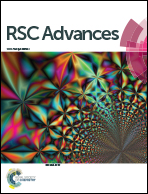Polymer-assisted self-assembly of silver nanoparticles into interconnected morphology and enhanced surface electric conductivity
Abstract
Polymer films with an embedded silver surface and moderate electric conductivity were facilely fabricated. The silver/polymer nanocomposite films were prepared by homogenizing silver nitrate in aqueous poly(vinyl alcohol) (PVA), solution casting, evaporating water, and further annealing. During the process, the chemical transformations involved the initial generation of a unique fern-like morphology from the AgNO3–PVA complexes, reduction of silver nitrate into silver nanoparticles (AgNPs), and Ag particle migration and self-assembling into a 3D interconnected network on the film surface. Heating at 100 °C for 24 h resulted in the reduction of AgNO3 into AgNPs (50 to 200 nm in diameter) that consequently migrated and melted into an interconnected network in the film's surface upon annealing at 250 °C. The resulting film had a surface sheet resistance of 1.0 Ω sq−1, which is a significant drop from the value of 2.0 × 108 Ω sq−1 for the pristine PVA. The films were analyzed by using UV-Visible spectroscopy, scanning electron microscopy, transmission electron microscopy, energy-dispersive X-ray spectroscopy, and electric conductivity measurements by a four-point probe meter. The hierarchical self-assembly of the silver species was largely directed by the initial formation of the fern-like morphology from AgNO3–PVA complexes. The ultimate construction of an interconnected Ag pattern led to PVA films with enhanced surface electric conductivity that is capable of lighting LED bulbs.


 Please wait while we load your content...
Please wait while we load your content...